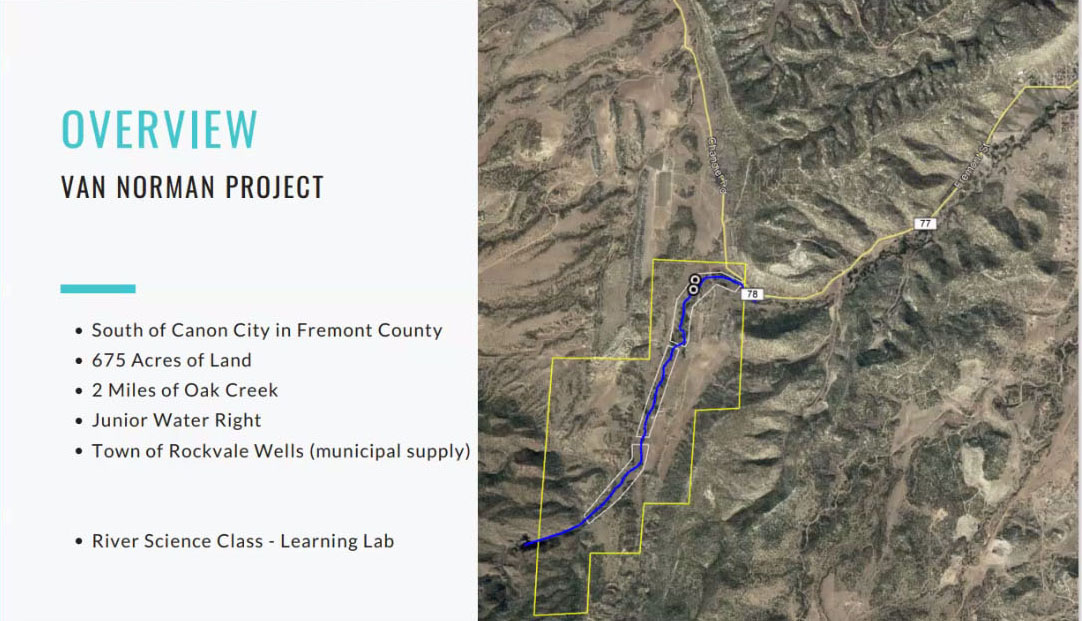Members of the Upper Arkansas Water Conservancy District board of directors agreed to support a stream restoration project for a 2-mile section of Oak Creek on the Van Norman Ranch near Cañon City.
Luke Javernick, executive director of Cañon City-based River Science, provided an overview of the project at the District’s May board meeting.
As a demonstration project, the endeavor promises to provide important information to guide future restoration efforts, and since the land lies within the Upper Ark District, directors and staff agreed on the importance of being involved to better understand the risk to water rights as well as the benefits.
Javernick said the benefits of “process-based stream restoration” include wildfire suppression and habitat improvements in the stream as well as in the riparian zone. “But the real impact is restoring hydrologic connectivity between the surface water and groundwater.”
Process-based restoration involves hand-building stream features that mimic natural structures, he said. “We’re mimicking nature, encouraging natural river processes for beneficial restoration,” and those structures can be modified or removed to accommodate the dynamics of the stream. “It takes time … five to 10 years.”
From the District’s perspective, one of the most important questions the project will attempt to answer is how stream restoration effects flows and, therefore, water rights.
“If you’re slowing the water down and allowing it to soak into the aquifer, when do you get that equilibrium?” Javernick asked. “We need UAWCD support because you’re the experts in water rights administration. … We need your help in navigating what types of creative solutions might be available.”
The Van Normans have an Oak Creek water right. However, the Town of Rockvale has the senior water right on Oak Creek, Javernick said, and “the Town is onboard.”
The Colorado Water Conservation Board has awarded a $99,900 grant to the Van Norman Project, and Javernick indicated that the Phase I project budget includes $10,000 for the Upper Ark District. “We’re asking for a $10,000 (in-kind) match.”
“I have some tremendous concerns,” said Board Chairman Tim Canterbury. “We need to be involved in this. … If I’m a downstream junior water right, at what point am I being injured by that restoration project. We need good science. I’m in favor of being involved with the project to better understand the impacts.”
Engineering consultant Chris Manera commented, “I worked with someone who had problems” as a result of an upstream landowner building beaver dams to mitigate incised channels similar to Oak Creek.
“These projects aren’t going to go away,” said Terry Scanga, general manager of the Upper Ark District. “So we’re either an objector (in Water Court) or we work with them and figure out a way to do it without injuring water rights. … I think it’s a proactive approach” to support this project.
“What Oak Creek needs is a bunch of beaver dams,” said Director Bill Donley, Custer County. “If this could replicate that, that could be a good thing.”
District 12 Water Commissioner Dan Henrichs noted that Colorado Water rights “are subject to the conditions” at the time the water right was appropriated, so returning a stream to its condition at the time of appropriation is supported by Colorado water law.
Scanga expressed concern about evaporative losses and the ability to replace those losses to avoid injuring downstream water rights. “Somehow there’s got to be a way of taking into account the water rights administration. We need to figure out how to do that and accomplish your goals.”
Scanga recommended that Javernick consult with Manera and District Hydrologist Jord Gertson to develop a plan and scope of work “with time, hours and dollars on it and then come back to the board.”
The board agreed, and when Vice Chair Greg Felt asked for consensus to support the project, no one expressed objections.





